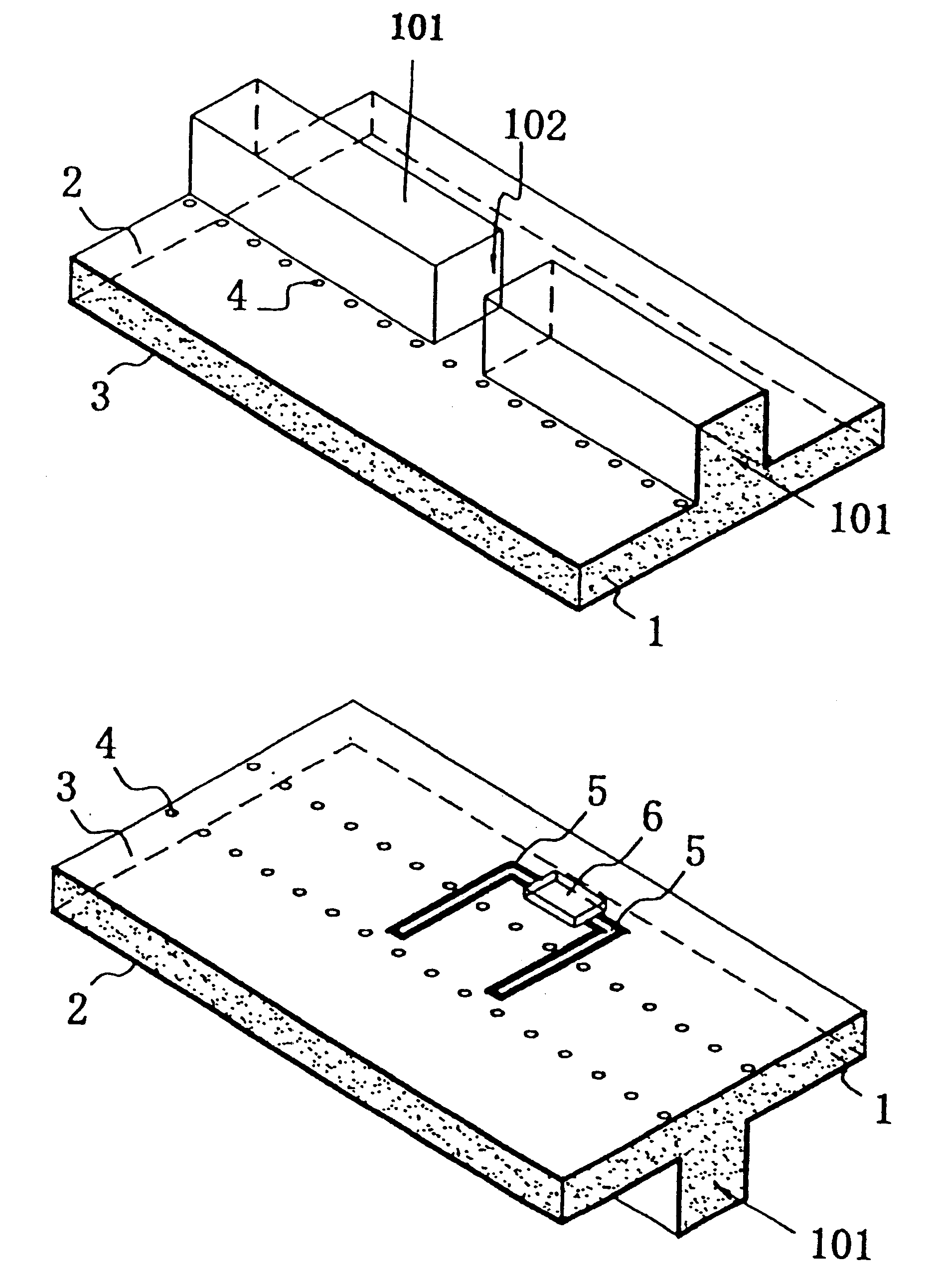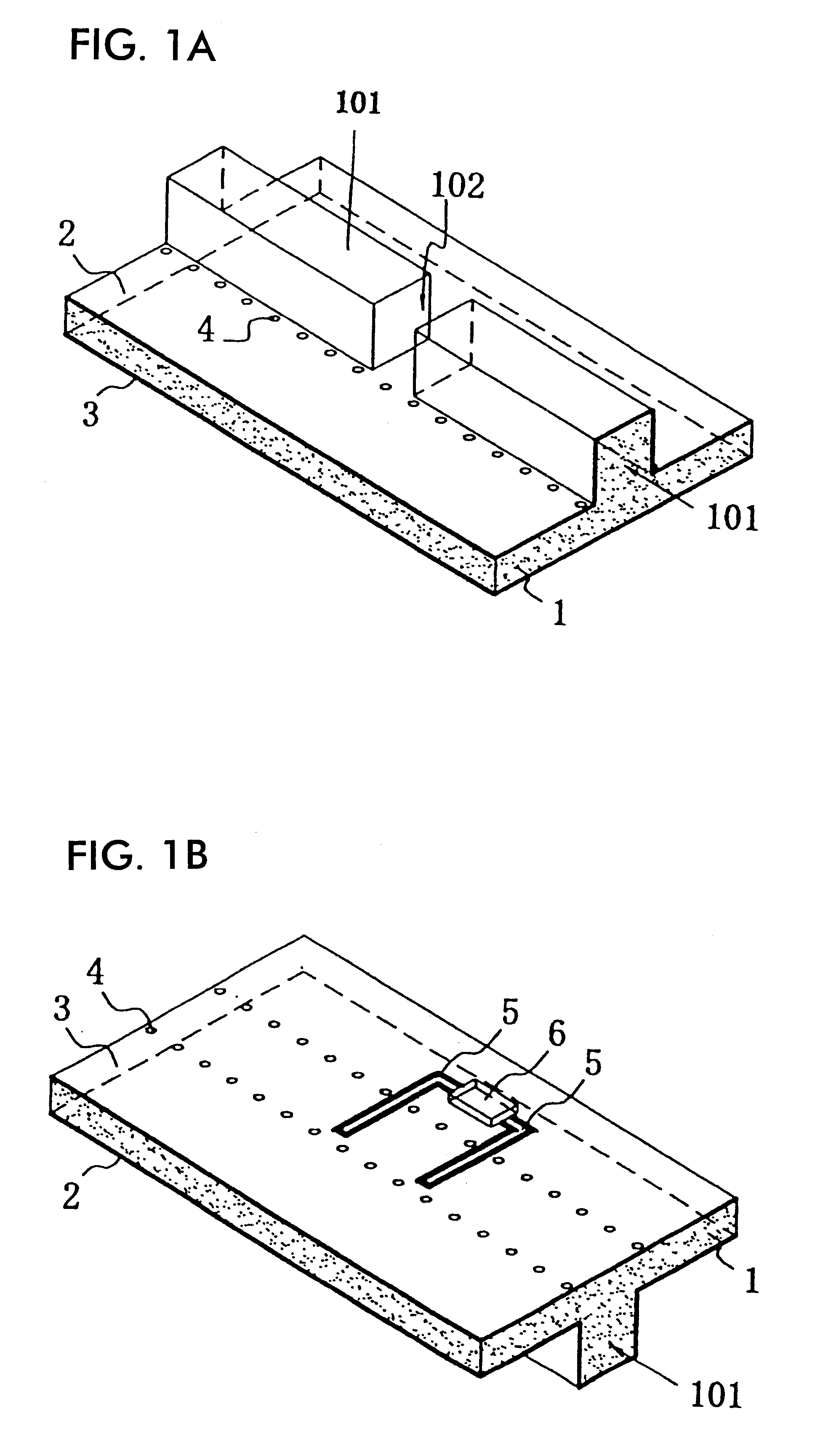Transmission line, integrated circuit, and transmitter receiver
a technology of integrated circuits and transmitters, applied in the direction of coupling devices, electrical devices, waveguides, etc., can solve the problems of inability to obtain suitable transmission characteristics, inability to receive the necessary signal on the surface of the electrode circuit, and disadvantageous increase of the conductor
- Summary
- Abstract
- Description
- Claims
- Application Information
AI Technical Summary
Benefits of technology
Problems solved by technology
Method used
Image
Examples
first embodiment
Hereinafter, the configuration of a transmission line will be described with reference to FIGS. 1A to 4.
FIGS. 1A and 1B are perspective views of the transmission line wherein FIG. 1A shows a lower side and FIG. 1B shows an upper side.
In FIGS. 1A and 1B, a dielectric substrate 1, a lower-surface electrode 2, an upper-surface electrode 3, through-holes 4, coplanar lines 5, a circuit element 6, protrusions 101, and a discontinuous portion 102 are shown.
The protrusions 101 extend in line one after another in a direction perpendicular to the cross section in a part of the dielectric substrate 1, with the discontinuous portion 102 therebetween. The lower-surface electrode 2 is formed on a main surface of the dielectric substrate 1 provided with the protrusions 101 and on the outer surfaces (side surfaces and upper surface) of the protrusions 101. The upper-surface electrode 3 is formed on substantially the whole area of the surface that is opposite to the lower-surface electrode 2. Furth...
second embodiment
Subsequently, the configuration of a transmission line will be described with reference to FIG. 5.
FIG. 5 is a perspective view of the transmission line.
In FIG. 5, the dielectric substrate 1, the lower-surface electrode 2, the upper-surface electrode 3, the through-holes 4, the protrusions 101, and a protrusion 103 are shown.
In the transmission line shown in FIG. 5, the protrusion 103, whose height is lower than that of the protrusions 101, is provided between the protrusions 101. The configuration of the transmission line is otherwise the same as the one shown in FIGS. 1A and 1B. The protrusion 103 is formed such that the distance from the upper-surface electrode 3 of the dielectric substrate 1 to the lower surface of the protrusion 103 is shorter than 1 / 2 of the wavelength of a transmission signal. Accordingly, the height of the H surface decreases, the cut-off frequency of the transmission path increases, the TE.sub.10 mode is interrupted at the protrusion 103, and thus electroma...
third embodiment
Next, the configuration of a transmission line will be described with reference to FIG. 6.
FIG. 6 is a perspective view of the transmission line.
In FIG. 6, the dielectric substrate 1, the lower-surface electrode 2, the upper-surface electrode 3, the through-holes 4, the protrusions 101, and indented portions 104 are shown.
In the transmission line shown in FIG. 6, the indented portions 104 are provided between the protrusions 101 which extend one after another, such that the indented portions 104 are recessed at the two sides in the width direction of the protrusions 101. The configuration of the transmission line is otherwise the same as the one shown in FIGS. 1A and 1B.
In this configuration, the operation is the same as that of the transmission line shown in FIG. 5, utilizing the TE.sub.10 mode in which the electromagnetic fields are turned by 90 degrees. The indented portions 104 contribute to suppress leakage between the protrusions 101, and thus the transmission characteristic o...
PUM
 Login to View More
Login to View More Abstract
Description
Claims
Application Information
 Login to View More
Login to View More - R&D
- Intellectual Property
- Life Sciences
- Materials
- Tech Scout
- Unparalleled Data Quality
- Higher Quality Content
- 60% Fewer Hallucinations
Browse by: Latest US Patents, China's latest patents, Technical Efficacy Thesaurus, Application Domain, Technology Topic, Popular Technical Reports.
© 2025 PatSnap. All rights reserved.Legal|Privacy policy|Modern Slavery Act Transparency Statement|Sitemap|About US| Contact US: help@patsnap.com



